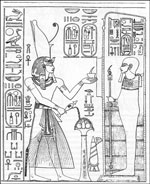
Cult
of the Gods
The deities required food, drink, clothing, and rituals of purification
to sustain them as the protectors of mankind against the forces
of chaos. These needs were met in the course of rituals performed
before a cult statue of the god that was thought to provide an abode
for the deity's soul. Although no complete example of such a cult
statue has been identified, the Restoration Stela of Tutankhamun
describes the Amun statue as "his holy image being of electrum,
lapis lazuli, turquoise and every precious stone." In theory,
the king, as the highest priest of the land, approached the sanctuary
where the statue stood three times each day (in actuality, the high
priest of the temple, accompanied by choirs of temple singers and
ranks of other priests, substituted for the king). He opened the
doors of the shrine that enclosed the statue and performed purification
rituals. The cult statue was washed, anointed with perfumes, and
dressed in clothes and necklaces. Food and drink were laid before
the image of the god for divine sustenance. After a suitable interval
for the god to consume the offerings, they were removed and reverted
to the temple staff.
Processions of the god were an important feature of the cult. During festivals
the statue of the god was removed from his or her sanctuary and placed in
a portable shrine which was, in turn, placed on a boat. These ritual craft
could be quite large; indeed, the texts from Tutankhamun claim that it was
carried by eleven pairs of priests. The sacred boat processions might circumambulate
the temple or make a pilgrimage from one temple to another, accompanied
by temple personnel and local residents who sang, danced, and acclaimed
the god.
«
previous
3 of 6
next
»
|
 |

|
 |


Figure
2: King Ramesses III. »
| E
X P L O R E |
| The
Further Exploration page has many links to great
sites about Ancient
Egypt. |
|
|
|